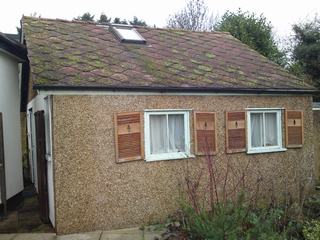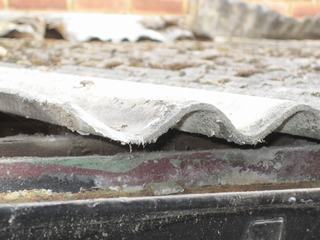The Dangers of Asbestos
Tuesday, 29th March 2011
Surveying
On a recent Full Building Survey of a 1930’s semi detached house, we discovered that the garage roof covering consisted of asbestos tiles. The garage itself was in a poor state of repair and the client had already informed us that if the sale went through she would be demolishing it.
 Asbestos was a widely used material between the 1950’s and 1980’s, it is a naturally occurring fibrous material derived from metamorphic rocks; most of the asbestos in the UK would have originally been imported from Canada.
Asbestos was a widely used material between the 1950’s and 1980’s, it is a naturally occurring fibrous material derived from metamorphic rocks; most of the asbestos in the UK would have originally been imported from Canada.
Asbestos is not only strong and flexible, but it also has a natural resistance to heat, fire, chemicals and electricity, these physical characteristics meant that as a construction material it was applied to a variety of products; estimates suggest that at its peak asbestos was used in over 3,000 products ranging from vinyl flooring, roofing tiles, insulation and even domestic appliances.
There are three types of Asbestos: Brown (Amosite), Blue (Crocidolite) and White (Chrysotile). A professional survey should be sought prior to the removal of the asbestos containing material (ACM), this will not only identify which type of asbestos it is, but will also identify the level of risk it posses to the occupants and therefore whether it should be removed as a matter of urgency of left in place undisturbed.
When left untouched and intact asbestos doesn’t pose a risk to those around it, however when disturbed, for example drilling or cutting into it, the fibres can become air borne and can be inhaled by the various occupants of the property. This is where the danger lies; estimates suggest that asbestos is responsible for over 4,000 deaths a year in the UK alone.
Although the asbestos roof stood out and raised some concern with the client, we advised her that it is not uncommon for the material to be in-situ in older buildings. Our recommendation was that she first has the asbestos tested to establish which type it is and then arrange act on the professional advice of the licensed contractor.
In terms of the roof, licensed removal means the roof would be dismantled and the tiles removed in a protected, controlled and sealed environment; the ACM would then be double bagged, sealed and labelled.
 One of the benefits of a Full Building Survey is that it lets you know exactly what you’re buying into; in this case it informed the client of the existence of the asbestos tiled roof & recommended a suitable course of action. She was then able to proceed with her purchase with full peace of mind and a full understanding of her future home.
One of the benefits of a Full Building Survey is that it lets you know exactly what you’re buying into; in this case it informed the client of the existence of the asbestos tiled roof & recommended a suitable course of action. She was then able to proceed with her purchase with full peace of mind and a full understanding of her future home.
Our surveyors are always happy to discuss the property you’re purchasing and your specific survey requirements, if you would like to enquire about a Full Building Survey please call our surveying team on 020 8360 7615 and we will be happy to discuss the property in further detail.
